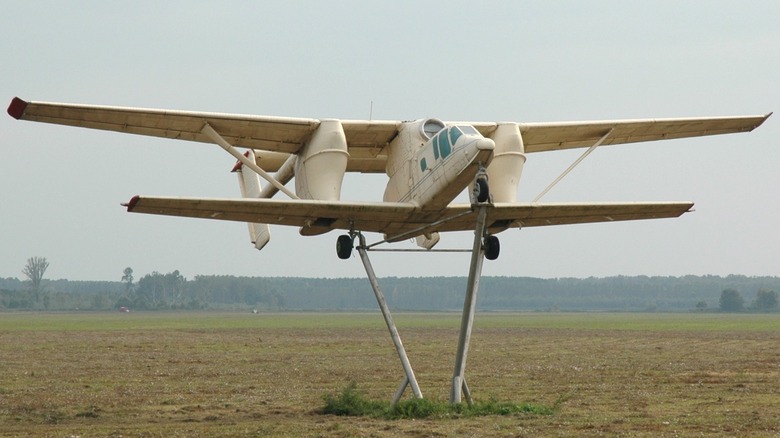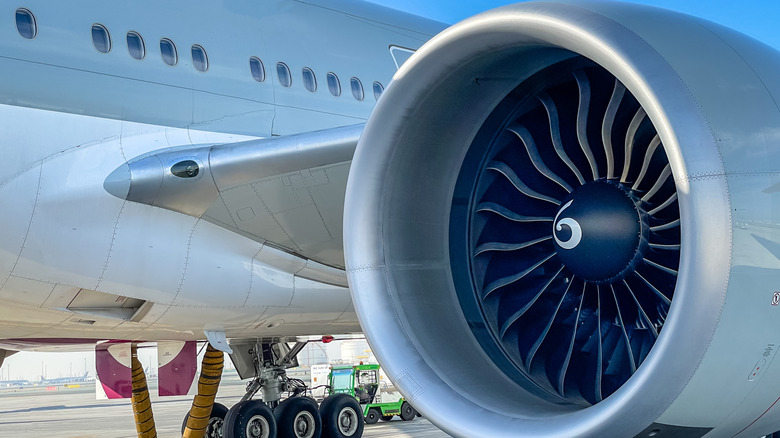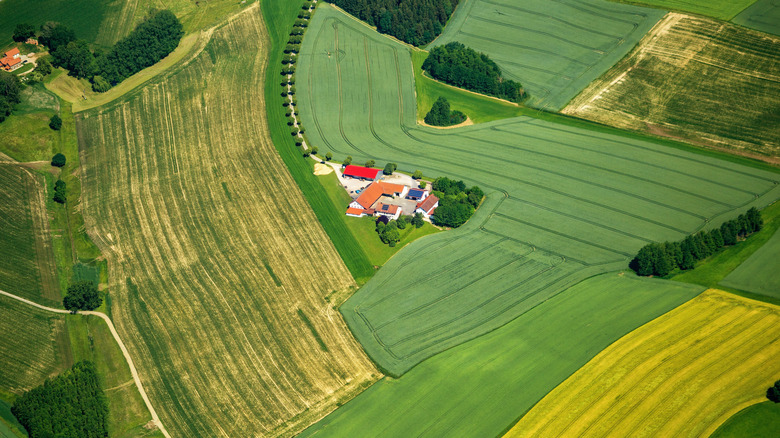The Record For Slowest Jet Ever Made Goes To This Aircraft
Anyone who's ever played with a paper airplane might ask: "How slow can a plane go before it just ... drops?" There are lots of factors involved, particularly the weight of the aircraft, but the absolute minimum for a small plane is only less than 31 miles per hour, or approximately three times less than some of us have probably driven on the highway while not dying in a car crash. That includes take-off speed as well as the speed necessary to stay in the sky. But that's a plane, not a jet. A jet isn't merely a super fast plane that zooms around pew-pewing fleets of enemy fighters. A jet has a specific type of engine — a jet engine. The slowest jet ever recorded flew much faster than 31 mph, but still only reached 120 mph at top speed. For context, a private jet typically cruises along at a cool 500 to 600 mph.
Enter the tale of Soviet-dominated Poland in the 1970s and the PZL M-15 "Belphegor," the most ungainly and ugly winged thing to barely grace the skies with its crop-dusting bulk. Crop-dusting, you say? Yes. The PZL M-15 wasn't a jet fighter, but was supposed to be a brilliant, revolutionary, cost-cutting, etc., etc., solution to the old Antonov An-2R crop-dusting biplane derived from an original, World War II-era U.S.S.R. plane. Those old An-2Rs couldn't last forever, and all those Eastern European wheat and barley fields needed their chemical showers. In the end, an absurd amount of engineering entanglements mingled with the stupidest kind of bureaucratic bungling to create a mere 175 PZL M-15s by 1981, when the planes were discontinued.
Why was the PZL M-15 considered a jet?
An aircraft, an airplane, a plane, a jet, a jet plane, etc.: What's the difference between any of these things? In order to understand the PZL M-15 Belphegor, we've got to dig into some technicalities. Folks tend to associate "plane" with the thing that retirees sit in while flying to Florida, and "jet" with the thing that Tom Cruise flew in "Top Gun" and "Top Gun: Maverick." But the difference is deeper than that, or at least more nuanced, and explains why the PZL M-15 Belphegor was so slow while also being classified as a jet.
First of all: Size doesn't matter when it comes to the difference between planes vs. jets. Big commercial aircraft like the Boeing 747 and small military aircraft like the U.S.'s super-advanced F-22 Raptor are both jets. This also means that aircraft design, function, and armaments (or lack thereof) also don't define a plane vs. a jet — not directly. Flying altitude, fuel capacity, and travel distance aren't defining characteristics of planes vs. jets, either, but more a consequence of aircraft design, function, and engine type. Speed also isn't a defining characteristic. The real difference between a plane and a jet is the engine type. A plane engine uses propellers, and a jet engine is a turbine engine that works by creating combustion.
This is exactly what Polish and Soviet governments talked about in the lead-in to the development of the PZL M-15. Why not use a jet engine on an agricultural vehicle? But as everyone involved would find out, there are good reasons why we typically pair different engine types with specific aircraft.
A hated Frankenstein's aircraft
It sounds like it could work in concept: "Hey, let's strap a gas-powered turbine on them cropdusters and dust them Polish crops hella fast, ya'll." Okay, maybe it sounds dumb. It must have sounded especially dumb to engineers because Soviet authorities really did want a jet engine jury-rigged onto the frame of the existing, propeller-based An-2R, two-winged agricultural biplane dating back to World War II. Never cut corners, people.
Engineers decided on a single jet engine directly on top of the body of the original An-2R plane. Then, they connected a second set of big, long wings to the top of this engine directly above the original wings. Then, it had a twin-boom component added to the back of the plane. Why not stick a coffee maker in the cockpit while we're at it? The whole, Frankenstein's PZL M-15 contraption had a maximum takeoff weigh of 12,456 pounds, a slow top speed of 120 mph, and a stall speed (when it falls from the sky) or 67 miles per hour.
The PZL M-15 also had a whole lot of farmers confused, as they were the ones who had to use and fix the things. The jet was also loud and clunky, which led to its nickname, Belphegor. "Belphegor" is actually a distortion of "Baal of Peor" from Numbers 25 in the Old Testament, a lovely vignette describing Israelite sexual escapades, some plague, impromptu executions like one spear thrust through the stomachs of two people, etc. That's how much everyone involved loved the PZL M-15. By 1981, only 175 had been built and the program was finished.


